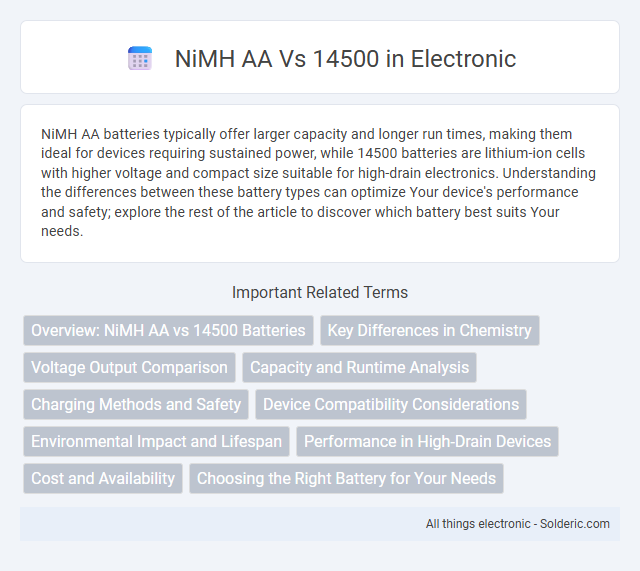NiMH AA batteries typically offer larger capacity and longer run times, making them ideal for devices requiring sustained power, while 14500 batteries are lithium-ion cells with higher voltage and compact size suitable for high-drain electronics. Understanding the differences between these battery types can optimize Your device's performance and safety; explore the rest of the article to discover which battery best suits Your needs.
Comparison Table
| Specification | NiMH AA | 14500 Li-ion |
|---|---|---|
| Battery Type | Nickel-Metal Hydride (NiMH) | Lithium-ion (Li-ion) |
| Nominal Voltage | 1.2V | 3.7V |
| Capacity Range | 1300-2800mAh | 600-1000mAh |
| Size | AA (14.5mm diameter x 50.5mm length) | 14500 (14mm diameter x 50mm length) |
| Recharge Cycles | 500-1000 cycles | 300-500 cycles |
| Self-discharge Rate | Moderate | Low |
| Weight | 23-30g | 20-25g |
| Common Applications | Remote controls, toys, flashlights | High-drain devices, flashlights, cameras |
| Cost | Generally lower | Generally higher |
Overview: NiMH AA vs 14500 Batteries
NiMH AA batteries typically measure 50.5mm in length with a diameter of 14.5mm and offer a nominal voltage of 1.2V, providing capacities ranging from 1,700 to 2,800mAh for use in various household devices. The 14500 battery, resembling the size and shape of a standard AA but slightly shorter at 50mm, also delivers a nominal voltage of 3.7V in lithium-ion variants or 1.2V in NiMH types, with capacities around 600 to 1,100mAh. Differences in voltage, capacity, and size impact device compatibility and runtime, making NiMH AA suitable for moderate-drain applications and 14500 ideal for compact devices requiring higher voltage or lithium-ion performance.
Key Differences in Chemistry
NiMH AA batteries use nickel-metal hydride chemistry designed for standard portable electronics, offering around 1.2 volts per cell with higher capacity and stable discharge rates. In contrast, 14500 batteries resemble lithium-ion cells at approximately 3.7 volts, featuring lithium chemistry that delivers higher energy density but requires specific chargers and protection circuits. This fundamental chemistry difference impacts voltage output, recharge cycle life, and suitable device compatibility.
Voltage Output Comparison
NiMH AA batteries typically have a nominal voltage of 1.2 volts, whereas 14500 lithium-ion batteries deliver a nominal voltage of 3.7 volts, offering significantly higher power output per cell. This voltage difference impacts device compatibility and performance, with 14500 batteries suited for high-drain electronics requiring greater energy density. AA NiMH cells provide stable voltage under load, making them reliable for low to moderate power consumption devices.
Capacity and Runtime Analysis
NiMH AA batteries typically offer capacities ranging from 1700 to 2500mAh, providing longer runtime compared to 14500 batteries, which usually have capacities around 600 to 900mAh. Despite their lower capacity, 14500 batteries deliver a higher voltage of 3.7V, making them suitable for devices requiring more power but shorter usage periods. Your choice depends on whether extended runtime (NiMH AA) or higher voltage output (14500) is more critical for your application.
Charging Methods and Safety
NiMH AA batteries typically require chargers designed for lower voltage and higher capacity cells, utilizing negative delta V or temperature-based methods to prevent overcharging and ensure safety. In contrast, 14500 lithium-ion batteries need smart chargers with constant current/constant voltage (CC/CV) charging profiles and built-in protections against overcharge, over-discharge, and short circuits. Using the correct charger type for each battery chemistry significantly reduces risks such as overheating, leakage, or thermal runaway, enhancing longevity and safety during charging cycles.
Device Compatibility Considerations
NiMH AA batteries fit most standard devices designed for size AA cells, providing broad compatibility for household electronics, remote controls, and toys. In contrast, 14500 batteries, with a similar size to AA but a higher voltage closer to lithium-ion cells, are often suited for high-drain devices like flashlights and some specialty gadgets, requiring your device to support the specific voltage to avoid damage. Always check your device's voltage and size requirements to ensure optimal performance and safety when choosing between NiMH AA and 14500 batteries.
Environmental Impact and Lifespan
NiMH AA batteries typically offer a longer lifespan with more recharge cycles compared to 14500 lithium-ion batteries, reducing overall environmental waste through extended usability. 14500 batteries, while providing higher energy density and performance, often have shorter lifespans and require more frequent replacement, increasing environmental impact due to manufacturing and disposal. NiMH AA batteries are generally more eco-friendly, featuring less toxic materials and higher recyclability rates than 14500 lithium-ion cells.
Performance in High-Drain Devices
NiMH AA batteries typically offer a capacity of 2000-2700mAh and maintain steady voltage under high-drain conditions, making them reliable for devices like digital cameras and flashlights. In contrast, 14500 batteries, similar in size to AA but with a lithium-ion chemistry, provide higher voltage (3.6-3.7V) and can deliver more consistent power in high-drain devices, but require compatible electronics designed for their increased voltage. The choice between NiMH AA and 14500 cells depends on the device's voltage requirements and ability to handle current draw, with 14500 often preferred for advanced high-drain electronics due to their higher energy density and stable output.
Cost and Availability
NiMH AA batteries offer broader availability and lower cost due to their widespread use in household devices and mass production. In contrast, 14500 batteries, while rechargeable like NiMH, tend to be priced higher and less commonly stocked because they are specialized lithium-ion cells typically used in high-performance electronics. Consumers seeking cost-efficiency and easy replacement favor NiMH AA cells for general applications.
Choosing the Right Battery for Your Needs
NiMH AA batteries typically offer 1900-2500mAh capacity with a nominal voltage of 1.2V, making them ideal for low to moderate power devices such as remote controls and clocks. In contrast, 14500 batteries provide higher voltages around 3.7V and capacities near 750-900mAh, suitable for high-drain electronics like flashlights and cameras. Selecting between NiMH AA and 14500 depends on device voltage requirements and desired runtime, ensuring optimal performance and safety.
NiMH AA vs 14500 Infographic

 solderic.com
solderic.com